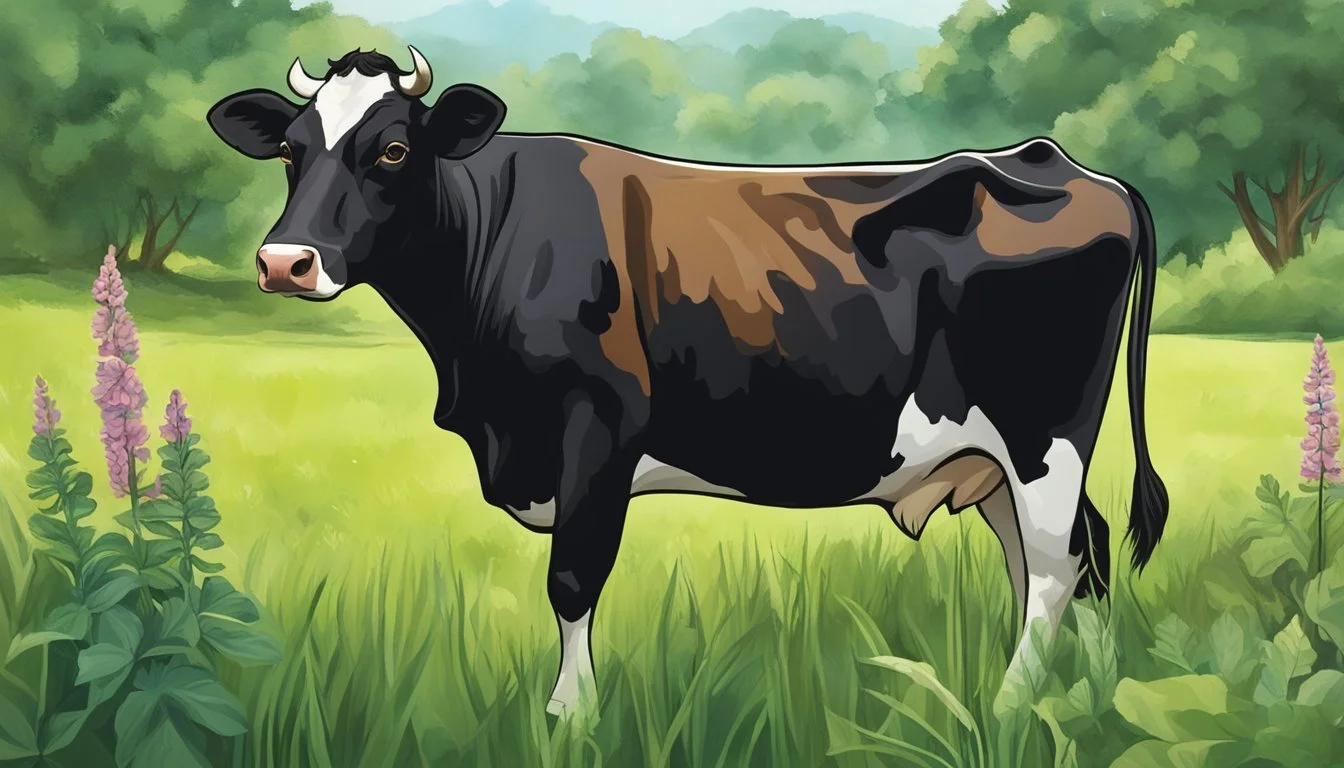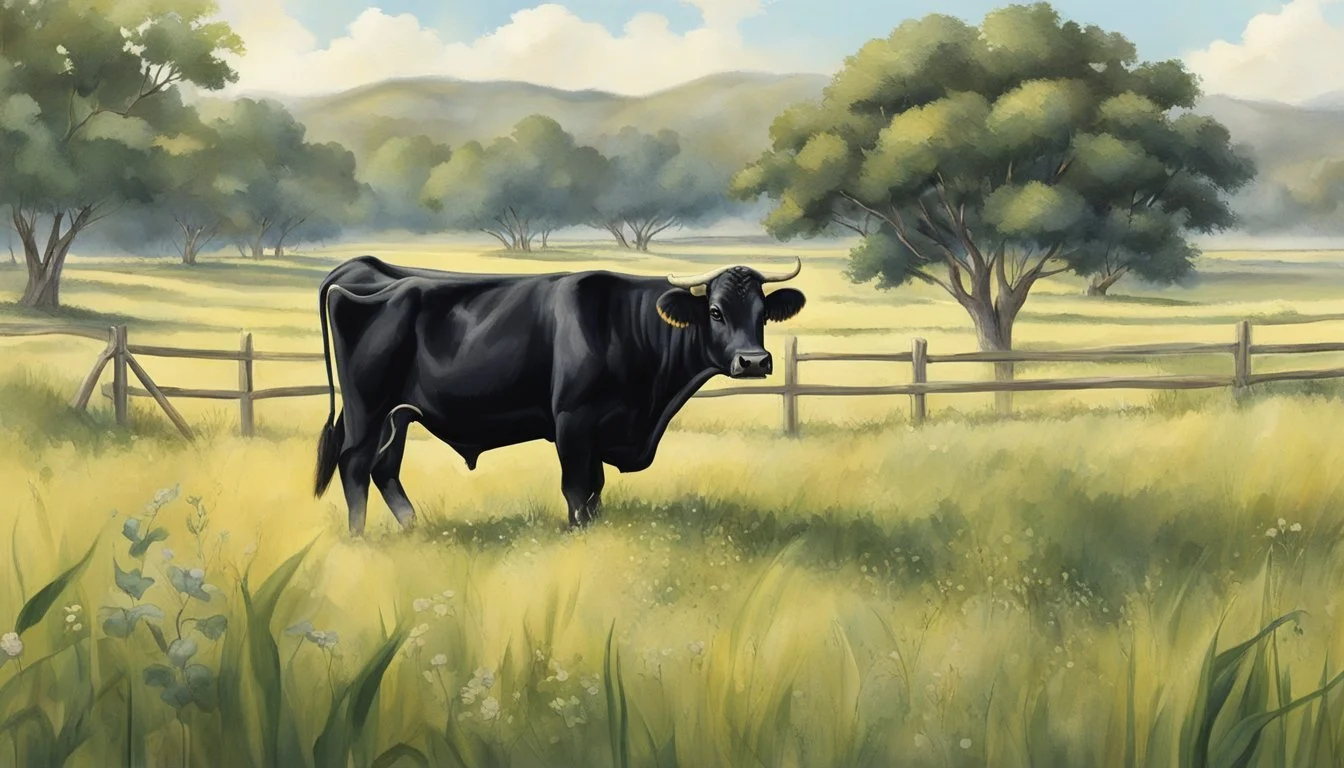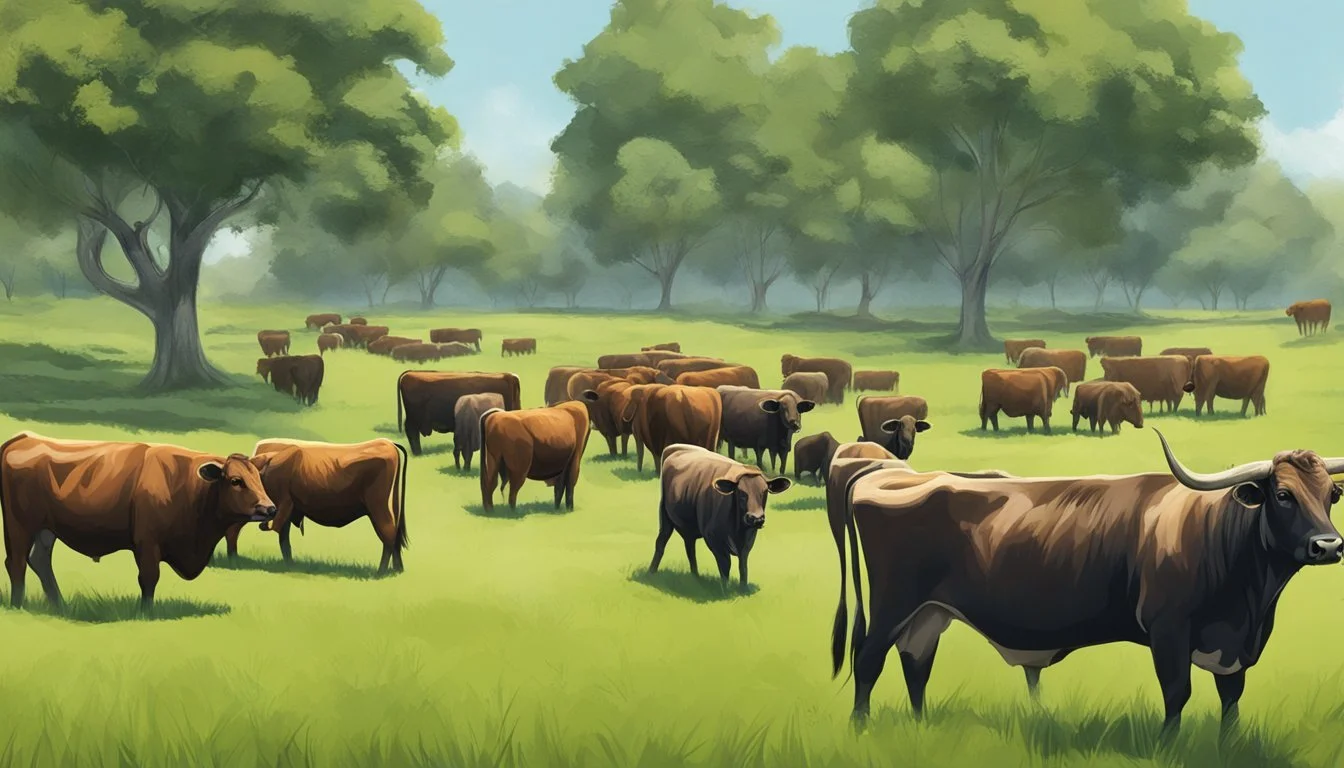The Importance of Trace Minerals in Dexter Cattle Diets
Balancing for Optimal Health
Optimal nutrition is vital for the health and productivity of Dexter cattle, a small breed known for its dual-purpose utility in meat and milk production. Trace minerals are key components of cattle diets, as they play crucial roles in various physiological processes, including immune function, reproduction, and growth. These minerals—such as copper, selenium, zinc, cobalt, iodine, and manganese—are required in minute quantities but are critical for maintaining homeostasis and preventing nutritional deficiencies or toxicitie
In Dexter cattle, as in other breeds, the balance of trace minerals is a delicate matter. An oversupply as well as a deficiency can lead to adverse health outcomes. For example, selenium is essential for antioxidant protection and thyroid function, while copper supports iron metabolism and cardiac health. Cobalt, while not directly a nutrient for the animals, is essential for the ruminal microbes that synthesize vitamin B-12, an important nutrient for cattle.
The supplementation of trace minerals in a Dexter cattle diet must be carefully managed. The source of the minerals, whether inorganic or organic, can influence their bioavailability and effectiveness. Ensuring that the mineral content in the fodder meets the specific needs of Dexter cattle without exceeding safe levels is essential for the sustainability of livestock production and the quality of meat and milk derived from these animals.
Fundamentals of Trace Minerals in Bovine Diet
The dietary inclusion of trace minerals is critical for the physiological and regulatory functions within Dexter cattle. These elements are required in minute quantities but have substantial impacts on cattle health and productivity.
Roles of Trace Minerals in Bovine Health
Trace minerals are pivotal in a range of bodily functions for Dexter cattle, including immune function, growth, and reproduction. Zinc (Zn) and Copper (Cu), for instance, play essential roles in enzyme synthesis and function, which are crucial for metabolic processes. Iron (Fe) is imperative for oxygen transport in the bloodstream, while Selenium (Se) is involved in protecting cells from oxidative stress and is vital for a robust immune system.
Essential Trace Minerals for Dexter Cattle
Dexter cattle require several essential trace minerals for optimal health:
Copper (Cu): Aids in iron absorption, connective tissue formation, and the immune response.
Zinc (Zn): Important for skin health, wound healing, and taste acuity.
Iron (Fe): Essential for hemoglobin formation and energy metabolism.
Manganese (Mn): Involved in enzyme activation and bone development.
Selenium (Se): Necessary for antioxidant protection and thyroid hormone metabolism.
Iodine (I): Crucial for thyroid hormone production, which regulates metabolic rate.
Molybdenum (Mo): Plays a part in enzymatic reactions that detoxify certain compounds.
The nutritional needs of Dexter cattle must be met through a carefully balanced diet that includes these trace minerals.
Bioavailability and Absorption Factors
The bioavailability of trace minerals refers to the proportion that is absorbed and utilized by the animal. Factors affecting bioavailability in Dexter cattle include:
Diet composition: The presence of other minerals can enhance or inhibit absorption. For instance, high levels of Molybdenum (Mo) can interfere with copper absorption.
Mineral source: Trace minerals can be provided in organic or inorganic forms; organic forms generally have higher bioavailability.
Physiological status: The life stage of the cattle, such as growth or pregnancy, can influence their mineral requirements.
Interactions with other nutrients: Certain vitamins and proteins can impact mineral absorption.
Understanding these factors is important to ensure that the dietary trace minerals are bioavailable to support the health and efficiency of Dexter cattle.
Trace Mineral Deficiencies and Toxicity
Dexter cattle require a balanced intake of trace minerals to maintain optimal health and productivity. Deviations from ideal levels can result in deficiency-related health issues or toxicity, which negatively impact growth, immunity, and reproduction.
Recognizing Deficiency Symptoms
Dexter cattle can exhibit clear symptoms when there is a deficiency in trace minerals. Signs to look for include:
Copper: Poor coat pigmentation, hair loss, and diarrhea.
Selenium: Weakened immunity leading to increased susceptibility to diseases, impaired growth, and muscle weakness.
Zinc: Reduced growth rates, poor hoof quality, and skin lesions.
Cobalt: Reduced appetite and weight loss.
Producers should note that symptoms might be subtle initially and can often be confused with other health problems. Regular monitoring and veterinary diagnostics are crucial to identify trace mineral deficiencies.
Managing Toxicity Levels
Toxicity occurs when cattle ingest excessive amounts of trace minerals. It can be as detrimental as deficiencies, causing health issues that may lead to death. Toxicity management strategies include:
Ensuring proper balance in mineral supplementation.
Monitoring forages and water sources for high mineral concentrations.
Reducing or eliminating additional mineral sources when toxicity signs appear, such as:
Mineral: Selenium
Toxicity Symptoms: Hair loss, hoof problems
Mineral: Copper
Toxicity Symptoms: Liver damage, jaundice
Mineral: Iron
Toxicity Symptoms: Gastrointestinal distress
Balanced feed formulations and frequent soil testing can help prevent mineral toxicity in Dexter cattle.
Impact of Deficiencies on Cattle Development
Deficiencies in trace minerals can impede the development of Dexter cattle in the following ways:
Growth: Essential trace minerals like zinc and copper are critical for growth. A deficiency may stunt development and reduce weight gain.
Immunity: Selenium and copper play a significant role in immune response. Inadequate levels can lead to increased disease incidence and oxidative stress.
Reproduction: Insufficient trace minerals can result in poor conception rates, increased miscarriage during gestation, and weakened offspring.
Stress Tolerance: A robust mineral status helps animals better cope with environmental stressors, ensuring they maintain health and productivity.
Addressing deficiencies through dietary adjustments and supplements is necessary to support the well-being of Dexter cattle. Producers should also consider the interaction of minerals with other dietary components and follow recommended guidelines to optimize animal development without causing toxicity.
Importance of Minerals for Cattle Growth and Reproduction
Trace minerals play a pivotal role in supporting the overall health, growth, and reproductive efficiency of Dexter cattle. Proper supplementation ensures optimal body condition and enhances the capability for successful breeding.
Enhancing Growth and Body Condition
Growth: For Dexter cattle, trace minerals such as zinc (Zn), selenium (Se), and manganese (Mn) are crucial for cellular functions that contribute to growth. Adequate levels of these minerals are required for the synthesis of proteins and the functioning of the enzymes that drive growth. For instance, manganese is vital for skeletal development, while zinc is essential for maintaining skin health and wound healing.
Trace Mineral: Zinc
Role in Growth: Protein synthesis
Recommended Supplemental Amount: 30 ppm (parts per million)
Trace Mineral: Selenium
Role in Growth: Antioxidant defense
Recommended Supplemental Amount: 0.1 to 0.3 ppm
Trace Mineral: Manganese
Role in Growth: Cartilage formation
Recommended Supplemental Amount: 20 ppm in growing cattle
Body Condition: A robust body condition is a direct indicator of a nutritious diet rich in essential minerals. Ensuring an appropriate supply of trace minerals supports average daily gain, which in turn reflects on the overall body condition of the cattle.
Optimizing Reproductive Performance
Reproduction and Fertility: The fertility of Dexter cattle is deeply influenced by the availability of trace minerals in their diet. Selenium is particularly important for preventing embryonic deaths, while both zinc and copper play significant roles in ovulation and conception processes.
Selenium: Integral for preventing reproductive disorders and ensuring the optimal function of the reproductive system.
Copper: Essential for hemoglobin formation, which has a secondary effect on reproductive performance due to its role in oxygen transport.
Reproductive Performance: Conception rates in Dexter cattle can significantly increase with proper mineral supplementation. By implementing a diet fortified with trace minerals, breeders can expect improvements in reproductive performance, including higher conception rates and healthier offspring.
Conception Rates: Inadequate levels of trace minerals like zinc can lead to reduced fertility. Supplementation is often necessary, especially in regions with deficient soil mineral content.
Supplementation Strategy: Considering soil and forage mineral levels to tailor a supplementation strategy is important for maintaining reproductive health.
Nutritional Strategies and Supplementation
Selecting the right supplementation methods and forms is crucial to ensure that Dexter cattle receive all necessary trace minerals for optimal health and productivity.
Designing Effective Mineral Supplementation Programs
A comprehensive mineral supplementation program takes into account local forage composition and potential deficiencies. Supplements should be customized to address the specific needs of Dexter cattle, taking into account the trace mineral content of local feed and forages. It's essential to consider the bioavailability of minerals in forages, as this can greatly influence the degree of supplementation required.
Trace Mineral Sources and Forms
Trace minerals in supplementation programs can be sourced from both organic and inorganic compounds. Chelated minerals, where a trace mineral is bound to an organic compound, often exhibit higher bioavailability. In comparison, salts may be less bioavailable but are commonly used and cost-effective. Important minerals for Dexter cattle include:
Supplemental Cu (copper)
Selenium
Zinc
Iodine
Supplementation Forms and Methods
Various forms of supplements are available, including bolus, loose minerals, and blocks. Boluses are administered orally and provide a slow release of minerals. Loose minerals and blocks allow animals to self-regulate intake but require careful management to prevent overconsumption. Mineral supplementation can also be incorporated into a mixed feed routine, ensuring a consistent intake with daily rations.
Trace Mineral Interactions and Synergy
Trace minerals are integral in maintaining physiological health and bolstering the immune system in Dexter cattle. They function not in isolation but through complex interactions and synergistic relationships that enhance nutrient utilization and immune response.
Interactions with Vitamins and Other Minerals
Trace minerals such as manganese (Mn), selenium (Se), and zinc (Zn) are crucial co-factors for several enzymes that facilitate vital biochemical reactions within the body. Their interactions with other minerals and vitamins can influence their bioavailability and efficacy. For example, an appropriate balance of Mn, Zn, and calcium (Ca) is necessary for optimal growth and bone development. Concurrently, copper (Cu) can interfere with the absorption of Se when present in high concentrations, necessitating careful balance in their dietary inclusion.
Interplay between minerals and vitamins is also key to health outcomes. For instance, Se is a core constituent of the enzyme glutathione peroxidase, which works with vitamin E to protect cell membranes from oxidative damage by reactive oxygen species. Together, they act as potent antioxidants ensuring the integrity of cell membranes and overall health during stressful physiological states such as gestation.
Maximizing Synergistic Benefits
To maximize the health benefits of trace minerals, their provided ratios need to reflect Dexter cattle's distinct mineral requirements. Adequate levels of Zn can improve immune function by promoting the generation of immune cells and by acting as an antioxidant to clear reactive oxygen species. Likewise, Se supports immune response through its antioxidants properties and influence on redox balance and inflammation modulation.
The pH level of the digestive system influences mineral absorption. Dexter cattle diets should ensure that the pH remains conducive to maximized absorption, which involves managing the interrelationships between different dietary minerals. This underscores the importance of designing cattle diets that not only meet individual mineral requirements but also consider mineral-to-mineral interactions to harness synergistic effects for improved health and performance.
Practical Feeding and Management Practices
The health and productivity of Dexter cattle significantly depend on the proper inclusion and management of trace minerals in their diet. This is crucial given the role trace minerals play in immune function, reproductive performance, and overall animal health.
Incorporating Trace Minerals into Rations
Producers need to formulate rations that ensure cattle receive all necessary trace minerals for optimal health and production. Cobalt, copper, zinc, manganese, and selenium are commonly included. Dexter cattle rations should have a balanced supply of these trace minerals which interact with the key systems affecting dry matter intake (DMI), protein synthesis, fat metabolism, and energy production.
Ration Composition:
Protein: Essential for growth and milk production.
Energy: Required for maintenance and productive processes.
Phosphorus: Important for bone development and energy transfer.
Nutritionists often recommend the use of specific mineral premixes tailored for the unique requirements of Dexter cattle.
Assessment of Forage Mineral Content
Regular forage analyses are vital to determine the existing levels of trace minerals available in the cattle's primary feed source. For example, the mineral content of grasses can indicate if supplementation is necessary. Adjustments are then made to the ration based on the forage analysis to ensure mineral adequacy.
Forage Analysis:
Sample periodically.
Test for key minerals: Cu, Zn, Mn, Se.
Compare results with required nutritional levels.
Adjusting Mineral Levels with Seasonal Changes
The mineral content in forages can fluctuate with the seasons. Seasonal changes often require adjustments to the mineral supplementation to maintain cattle health and production levels.
Seasonal Adjustment Strategies:
Increase copper and zinc during periods of high stress, like calving.
Adjust levels to combat mineral antagonists common in different seasons.
Producers should work with a nutritionist to monitor mineral status regularly and adapt their mineral program to seasonal forage changes ensuring cattle receive an optimal balance for their production phase and environmental conditions.
Industry Standards and Regulatory Aspects
In the realm of Dexter cattle nutrition, specific guidelines have been established to optimize health and performance. These are derived from extensive research and are critical in guiding safe and effective mineral supplementation.
National and International Guidelines
The National Research Council (NRC) provides a framework for mineral requirements in cattle diets, underpinning industry standards. The NRC's recommendations serve to inform livestock producers about the essential trace minerals necessary for sustaining animal health and performance. These guidelines are considered both nationally and internationally as the cornerstone for developing cattle nutrient programs. Trace minerals such as zinc, copper, manganese, and selenium are included in these recommendations, with specified amounts to meet the nutritional needs of cattle at various stages of growth and lactation.
Environmental and Regulatory Considerations
Regulatory entities monitor and enforce adherence to feeding practices that ensure not only animal health but also environmental protection. The environmental impact of trace mineral excretion into the ecosystem is a significant concern. Regulatory standards, therefore, often dictate the permissible levels of trace mineral supplementation to prevent excesses that could lead to soil and water contamination. Additionally, there are regulations in place within the USA to prevent health issues that may arise from incorrect dosages of trace minerals, safeguarding both animal welfare and environmental health. Compliance with these regulatory standards ensures responsible management practices are upheld within the industry.
Advancements in Trace Mineral Research
As research in animal nutrition advances, significant progress has been made in understanding the role of trace minerals in Dexter cattle diets. These developments are driving innovations in mineral supplementation and the enhancement of cattle health and production efficiency.
Recent Studies and Innovations
Recent studies have focused on refining the dietary recommendations for trace minerals such as cobalt, copper, iron, manganese, and zinc because of their crucial roles in catalyzing enzymatic reactions, including those involving superoxide dismutase and glutathione peroxidase. Innovations include the precision feeding practices to match the exact nutritional needs of Dexter cattle, based on their specific physiological stages, to optimize metabolic functions. Research findings suggest that the adjusted feeding practices can influence the excretion patterns of these micronutrients, thereby reducing environmental impacts.
Micronutrient Bioavailability: Current research is exploring the relative bioavailability of different forms of trace minerals. The bioavailability is key to ensuring that cattle can absorb and utilize these minerals efficiently, which ultimately affects their health and productivity. For example, studies compare the bioefficacy of inorganic versus organic trace mineral forms to determine which is more beneficial in cattle diets.
The Future of Trace Minerals in Cattle Nutrition
Looking forward, advancements in the field of trace mineral nutrition are anticipated to leverage technology for more detailed monitoring and adjusting of mineral levels in cattle diets. Research aims not only to enhance cattle production but also to improve overall herd health which may have implications in reducing the reliance on antibiotics.
Genetic Understanding: Future studies will likely investigate the genetic factors influencing mineral utilization in cattle, allowing for personalized nutrition plans. This could result in further optimization of the cattle's immune function and antioxidative status, as researchers gain deeper insight into the complex interactions between genetics and mineral nutrition.
Environmental Sustainability: The aspect of environmental stewardship is becoming increasingly important, with advancements aimed at reducing the trace mineral footprint in ecosystems. Efforts are being made to develop more sustainable methods of supplementation that satisfy animal health requirements while minimizing environmental contamination.
Case Studies and Practical Examples
In the context of Dexter cattle nutrition, the specific roles and effects of trace minerals have been illuminated through practical farm applications and comparative analyses. These real-world examples shed light on the direct outcomes of trace mineral management on both beef and dairy variants of Dexter cattle.
Successful Farm Implementations
Case studies demonstrate the tangible benefits of trace mineral implementation in Dexter cattle diets. Farms that have carefully balanced diets with trace minerals such as zinc (Zn), copper (Cu), manganese (Mn), and selenium (Se) report improvements in cattle health and productivity. For instance, a dairy farm incorporating a precise blend of these minerals observed a significant reduction in mastitis, an infection of the udder, consequently leading to higher milk yields.
Beef cattle operations integrating cobalt (Co) and iron (Fe) have similarly recorded enhanced growth rates and better meat quality. The Oxford County Dexter Study highlighted specific outcomes with Co supplementation:
Increased daily weight gain by 5%.
Improved meat marbling, enhancing flavor.
Practical examples further indicate that strategic grazing management that considers the natural mineral content of pastures can lead to improvements in animal health and reduce the need for additional supplementation.
Comparative Analysis of Supplementation Techniques
Comparative studies between sulfate and hydroxy trace mineral sources in Dexter cattle have revealed a nuanced understanding of mineral absorption and retention. Sulfate sources have been traditionally used, yet recent analyses suggest that hydroxy trace minerals are better utilized within the animal's body.
A side-by-side assessment in grazing cattle demonstrated that hydroxy trace mineral supplementation enhanced overall health more effectively than sulfates. Key findings included:
A 10% improvement in immune response was noted in cattle receiving hydroxy trace minerals.
Foot health was markedly better in hydroxy groups, decreasing the incidence of lameness.
These case studies and comparative analyses confirm the necessity of including trace minerals in Dexter cattle diets, whether grazing or stall-fed. The implications for animal nutrition and health are clear, offering a roadmap for farmers aiming to optimize the well-being and productivity of their herds.
Conclusion
In the context of Dexter cattle diets, trace minerals such as zinc (Zn), copper (Cu), manganese (Mn), and selenium (Se) are indispensable for optimal animal performance. Research underscores their pivotal roles in various physiological processes, including immune function, oxidative metabolism, and energy production.
It is well-established that management of trace minerals is a subtle balance. Supplementation must be adequate to meet the dietary requirements without leading to an excess, which could be detrimental. Soil composition and the resultant forage quality significantly influence the trace mineral content available to grazing livestock. Hence, livestock producers are encouraged to be vigilant of the soil pH levels and engage in practices that sustain the availability of these essential nutrients.
The strategic supplementation of trace minerals can lead to enhanced health and productivity of Dexter cattle. It not only supports the individual animal’s well-being but also contributes to the sustainability of the production system by potentially reducing the need for antibiotics and improving overall herd health.
Through continual learning and the application of up-to-date research findings, farmers can ensure that their herds receive a balanced diet that promotes both productivity and health. Investing in research and knowledge acquisition remains a core aspect of advancing cattle nutrition, leading to more efficient and sustainable farming practices.








